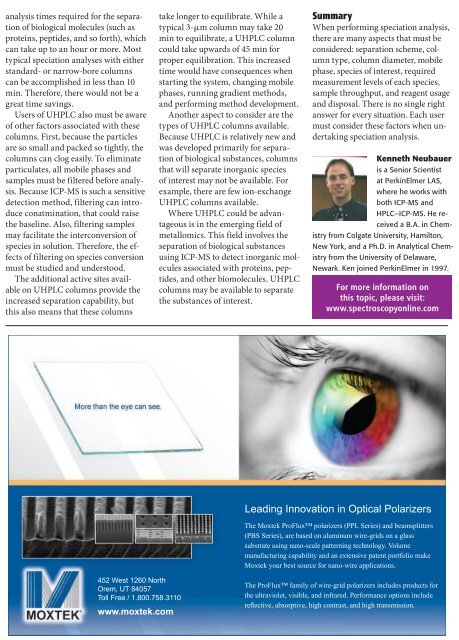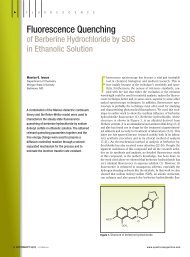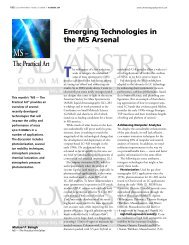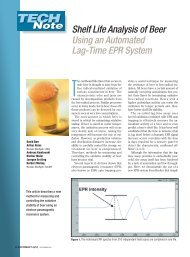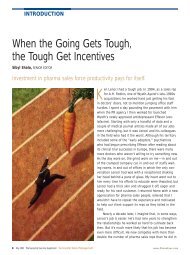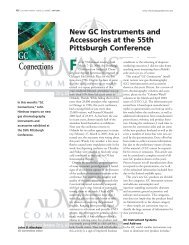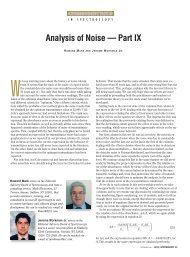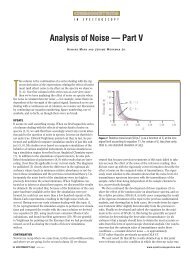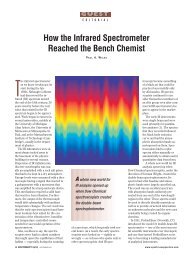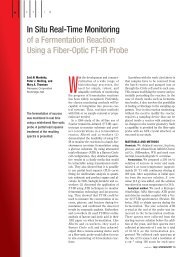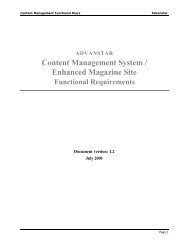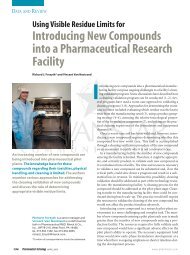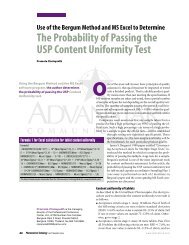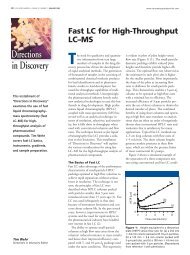Nucleic Acid Analysis with UV-vis and NMR - Spectroscopy
Nucleic Acid Analysis with UV-vis and NMR - Spectroscopy
Nucleic Acid Analysis with UV-vis and NMR - Spectroscopy
You also want an ePaper? Increase the reach of your titles
YUMPU automatically turns print PDFs into web optimized ePapers that Google loves.
www.spectroscopyonline.com<br />
November 2009 <strong>Spectroscopy</strong> 24(11) 33<br />
analysis times required for the separation<br />
of biological molecules (such as<br />
proteins, peptides, <strong>and</strong> so forth), which<br />
can take up to an hour or more. Most<br />
typical speciation analyses <strong>with</strong> either<br />
st<strong>and</strong>ard- or narrow-bore columns<br />
can be accomplished in less than 10<br />
min. Therefore, there would not be a<br />
great time savings.<br />
Users of UHPLC also must be aware<br />
of other factors associated <strong>with</strong> these<br />
columns. First, because the particles<br />
are so small <strong>and</strong> packed so tightly, the<br />
columns can clog easily. To eliminate<br />
particulates, all mobile phases <strong>and</strong><br />
samples must be filtered before analysis.<br />
Because ICP-MS is such a sensitive<br />
detection method, filtering can introduce<br />
conatmination, that could raise<br />
the baseline. Also, filtering samples<br />
may facilitate the interconversion of<br />
species in solution. Therefore, the effects<br />
of filtering on species conversion<br />
must be studied <strong>and</strong> understood.<br />
The additional active sites available<br />
on UHPLC columns provide the<br />
increased separation capability, but<br />
this also means that these columns<br />
take longer to equilibrate. While a<br />
typical 3-µm column may take 20<br />
min to equilibrate, a UHPLC column<br />
could take upwards of 45 min for<br />
proper equilibration. This increased<br />
time would have consequences when<br />
starting the system, changing mobile<br />
phases, running gradient methods,<br />
<strong>and</strong> performing method development.<br />
Another aspect to consider are the<br />
types of UHPLC columns available.<br />
Because UHPLC is relatively new <strong>and</strong><br />
was developed primarily for separation<br />
of biological substances, columns<br />
that will separate inorganic species<br />
of interest may not be available. For<br />
example, there are few ion-exchange<br />
UHPLC columns available.<br />
Where UHPLC could be advantageous<br />
is in the emerging field of<br />
metallomics. This field involves the<br />
separation of biological substances<br />
using ICP-MS to detect inorganic molecules<br />
associated <strong>with</strong> proteins, peptides,<br />
<strong>and</strong> other biomolecules. UHPLC<br />
columns may be available to separate<br />
the substances of interest.<br />
Summary<br />
When performing speciation analysis,<br />
there are many aspects that must be<br />
considered: separation scheme, column<br />
type, column diameter, mobile<br />
phase, species of interest, required<br />
measurement levels of each species,<br />
sample throughput, <strong>and</strong> reagent usage<br />
<strong>and</strong> disposal. There is no single right<br />
answer for every situation. Each user<br />
must consider these factors when undertaking<br />
speciation analysis.<br />
Kenneth Neubauer<br />
is a Senior Scientist<br />
at PerkinElmer LAS,<br />
where he works <strong>with</strong><br />
both ICP-MS <strong>and</strong><br />
HPLC–ICP-MS. He received<br />
a B.A. in Chemistry<br />
from Colgate University, Hamilton,<br />
New York, <strong>and</strong> a Ph.D. in Analytical Chemistry<br />
from the University of Delaware,<br />
Newark. Ken joined PerkinElmer in 1997.<br />
For more information on<br />
this topic, please <strong>vis</strong>it:<br />
www.spectroscopyonline.com


